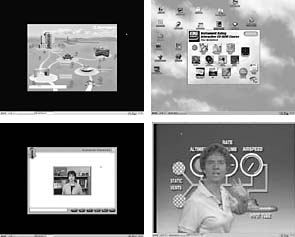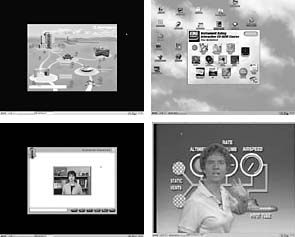
Anyone affluent enough to own an airplane didnt get that way by wasting time, thus the FAAs written licensing exams are supremely galling. Populated by too many dreary, pointless questions that have little connection to real-world flying, the writtens are potholes on the road to actually learning to fly.
The GA training industry has risen to the challenge, producing self-help courses on video, computer and audio tape media sharply focused on little but a passing grade. The latest-and the most impressive-are interactive computer offerings for the instrument rating by Jeppesen and King Schools. The latter has also released a new CD-ROM-based IFR flight training system in partnership with Cessna.
Although expensive in our view-$229.95 for the Jepp product and $279 for the King version-both of these programs are effective teaching tools, albeit still requiring a time-consuming slog. Alas, other than paying a ringer to take the exam in your stead, there’s no easy way to vanquish the written. (This is, of course, partially the FAAs intent.)
The Overview
Weve described these products as interactive multi-media and by that, we mean that both integrate video, audio and textual material in ways that can be customized to suit the user. For example, the programs can be narrowed to focus on just one topic area, say weather or IFR charts and plates. Or they can be broadened to pick randomly from all topic areas, simulating the FAA exam.
Significantly, both programs offer a simulated test option, complete with grading and identification of weak knowledge areas. Once youve made the grade, you can obtain a signoff to take the actual FAA exam. These differ from straight video or text offerings in that they theoretically save time, allowing you to skip what you know while zeroing in on what you don’t.
Jeppesen FliteSchool
Jeppesen has been at the flight training materials business for years and theyve refined that experience into FliteSchool, which we found to be well-designed and adequately supported with paper text.
The program is contained on a single CD-ROM and according to the specs, the minimum computer required is a Pentium 100 Mhz, 16 to 64MB of RAM and 30 to 40 MB of disc space, plus sound support. Its supposed to run on Windows95/98/NT 4.0. We loaded it on a Pentium 4 with a ton of RAM and found it ran fine. No hiccups during installation and nary a single Blue Screen of Death. Jeppesens IFR and commercial written training systems, of which FliteSchool is a part, are available in five versions with five price points. But only the $229.95 Electronic Kit version contains all the software and self-testing guides, which is what were covering here. Basic paper materials sell for as little as $114.95 and there are customized packages ranging up to $184.95. (See Jeppesens Web site for details.)
The paper shipped with FliteSchool is an IFR PTS, Jepps IFR text and a supplement with figures and drawings. Other than that, its all online, including the manual, FAR/AIM and other supporting material and something called the GFD or guided flight discovery text, which is an abbreviated version of the instrument training manual. Although its included in the package, were not sure you need it as a follow along.
Unlike the King offering, FliteSchool is less multi-media tour de force and more utilitarian get-to-the-point training, festooned with a gimmick here and there. At start-up, youre presented with a screen offering the choice of structured learning, self-study in the library or trying your luck straight away with a simulated FAA test. (We did; a dismal 55 percent. Back to the study hall.)
Each topic area-weather, procedures and regulations-is broken into numerous sub-topics categorized as they appear on the FAA exam. Clicking on source of weather information leads to a host of sub-topics. Click on convective sigmets and you get a 10-second audio spiel explaining what they are. Some of these modules contain video snippets as well.
Want more information? Back click into the online library to look up a FAR/AIM or text reference on the subject you wish to know more about. Or, for more focused study, set up the program in question-review mode and take a shot at each question. For more information, click a links bar on the bottom of the page and you can step over to the appropriate reference.
Fast, we’ll Designed
In general, we found FliteSchool to be quick on the draw and logically designed. The video and audio snippets are precise and the integration of graphics, while sparer than the King offering, is adequate, nonetheless.
Some minor complaints: The display itself occupies only a portion of the screen, with wide black borders. On our 17-inch monitor, fully 35 percent of the screen area is unused, making the reading of text an eye test at times.
Second, the navigation bars are customized rather than the standard Windows or video player symbology, including the ever-needed back button. Jepp uses an arrow for this; we would prefer a Web-style labeled back button since these days, browser symbology is standard and we see no reason not to use it.
Last, compared to Kings instructor overlay method, the video snippets are somewhat unimaginative, with the instructor doing a stand-up in an aviation-themed library. King, in our view, does it better.
King Schools
King Schools essentially owns the video self-study/self-test market, having integrated the high production-well, relatively high-values used in typical TV studios into aviation training products.
They offer a range of training materials, from private test prep material on up, lately to include an impressive CD-ROM based instrument training system done as a joint venture with Cessna. (See the sidebar for more.)
The instrument test prep program-the product were reviewing here-has been on the market for several years, having been brought over to CD-ROM from the King video tape series. Cost is $279, which includes a binder with 18 CD-ROMs and a text containing diagrams and the test questions. Sixteen of the discs have video, one is a set-up and the last is an online FAR-AIM for lookups.
A word here about video versus CD-ROM. The problem with slapping a video into the VCR and simply watching it is the static nature of video. There are no readily accessible links or references, other than those mentioned by the instructor or flashed on the screen. CD-ROM offers the potential of linking directly to the necessary reference material as its needed. For that reason, we think CD-ROM is the better choice, if you don’t mind hours spent peering at a monitor.
Unlike the Jeppesen system, the King CD-ROM offering is entirely video based lecture, not video snipped interspersed with audio voice over. (That explains why it requires 16 CD-ROMs.) This has its pros and cons, in our view. If you like the lecture format, the material is we’ll explained and practically spoon fed. If you don’t like it, youre in for hours of grating tedium to wade through the material. As video lecturing goes, we think the Kings are better at it than anyone. The lecturer- John or Martha King-stands before a film clip or graphic, explaining the topic at hand in lucid if not entertaining terms. The lectures are complete, well-paced and sharply focused on the written exam knowledge areas.
At the bottom of each screen is the standard (and familiar) Windows-style computer video player button set, with a stop and start control and a slider to advance or retreat the program.
Hit stop and the program immediately steps into text mode, displaying the appropriate FAA question and, if you wish, a one or two paragraph explanation. A couple of icons at the bottom of the window allow you to toggle through all the questions in that topic area.
Menu, Organization
As with Jepps version, the King Schools IFR exam prep is organized via a main menu that exactly tracks the FAA knowledge areas. This menu appears on the main screen at start-up. You can navigate it in order-what King recommends-or choose topic areas by interest and in order of strength or weakness.
The program tracks the questions youve reviewed and answered, right or wrong, and fills in the check boxes as you go. One menu item offers the choice of taking one of two practice exams or selecting a random choice of questions for a simulated exam.
Complete and pass two of the exams and send in your score and King will send back an endorsement to take the written exam. The system also includes an instructor signoff form so you can get your local CFII to clear you for the written. This system rightfully assumes you’ll take the exam at a computer-based testing center and the questions follow that format.
Since it uses far more storage-intensive video than does the Jeppesen program, the King system requires much shuffling of CD-ROMs and the insertion of a separate CD-ROM for FAR/AIM references, although most are well-covered in excerpts on each CD-ROM addressing the topic areas.
Both programs offer the necessary graphic information-charts, plates and forms-in pop-up form but we think King does this a bit better. In the Jepp program, the larger ones are shown in landscape mode when you really want portrait mode. Jeppesen provides a plug-in utility to rotate them, but its awkward to use.
Recommendations
If you need a push to get the written done because youre not a good self-studier, we think CD-ROM rather than video is the way to go. The interactivity makes study time more effective and relieves the tedium of pure video.
Both of these products are credible and will get the job done. Despite it being more expensive, we lean toward the King Schools program being the better value. As noted, the video is full-screen and the instructor overlay method is a terrific teaching strategy thats a welcome departure from the lecturing talking head.
Further, the King program is tightly knitted to the actual FAA questions disc-by-disc, without much superfluous blather. If youre busy and need to get the IFR training behind you, thats exactly what you’ll want.
Worth noting here that Jeppesen also has a Web-based IFR training system called JeppPrep. It offers 60-days of online access for $49.95 and similar progress tracking as the CD-ROM system. we’ll take a look at that product in a future issue.
Also With This Article
Click here to view the Training Checklist.
Click here to view “Teach Yourself IFR Comes to CD-ROM.”.
Click here to view the Jeppessen-Sanderson and King Addresses.
-by Paul Bertorelli


